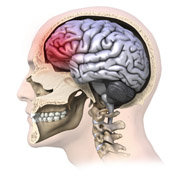Research and Innovation, UNL Office of

Center for Brain, Biology, and Behavior: Faculty Publications
ORCID IDs
https://orcid.org/0000-0001-9740-6354 Arthur Maerlender
Document Type
Article
Date of this Version
2019
Citation
Published in Journal of Clinical and Experimental Neuropsychology, 2019
doi 10.1080/13803395.2019.1641184
Abstract
Introduction: Tests of memory and speed of cognitive and motor responses have been the primary foci in sports-related concussion assessment. This study sought to assess the construct validity of neuropsychological tests within C3 Logix.
Method: Results of both baseline C3 Logix and the Immediate Post-Concussion Assessment and Cognitive Test (ImPACT) computerized tests from 86 Division I collegiate athletes were submitted to a two-factor confirmatory analysis using structural equation modeling. The two factors of Speed and Memory have been confirmed in previous studies of ImPACT.
Results: Results confirmed the two-factor model of ImPACT, whereas C3 Logix did not conform to a pure two-factor model. Instead, along with additional error terms, a cross-loading was required between Speed and Memory factors in order to obtain the best model fit (χ2 = 22.91, p= 0.12, CFI = 0.94, TLI = .90, RMSEA = 0.07 (90% CI [0.00, 0.13], SRMR = .06)): all factor loadings exceeded 0.30.
Conclusions: The final model suggested C3 Logix employs three pure indicators of Speed and one indicator of both Speed and Memory. The lack of a pure indicator of Memory in C3 Logix raises a concern about its specificity and ultimately, its sensitivity to a sports-related concussion.
Updated to reflect corrigendum 9/4/2019.
Included in
Behavior and Behavior Mechanisms Commons, Nervous System Commons, Other Analytical, Diagnostic and Therapeutic Techniques and Equipment Commons, Other Neuroscience and Neurobiology Commons, Other Psychiatry and Psychology Commons, Rehabilitation and Therapy Commons, Sports Sciences Commons


Comments
Copyright © 2019 Informa UK Limited, trading as Taylor & Francis Group